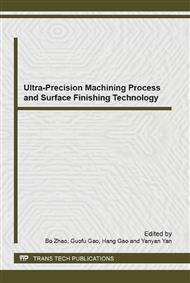p.20
p.24
p.28
p.32
p.36
p.40
p.44
p.48
p.52
Tool Wear Properties of Diamond-Cutting Ferrous Metal
Abstract:
The applicability of diamond cutting is greatly restricted due to the serious chemical wear for the machining of ferrous materials. The processes of diamond natural graphitization and graphitization in diamond/Fe interface were analysed by molecular dynamics (MD). Simulation proved that the graphitization temperature decreased from 5215 K of natural graphitization process to 1300 K at diamond/Fe interface, and diamond which near the Fe atoms was graphitized firstly. Diamond tool wear behavior during ordinary cutting and ultrasonic elliptical vibration cutting (UEVC) of NAK80, S136 was analysed. Results showed that the diamond tool wear decreased greatly in UEVC. MD Simulation and cutting experiments both demonstrated that lowering the temperature of the interface could effectively reduce the wear of diamond tool.
Info:
Periodical:
Pages:
36-39
Citation:
Online since:
October 2014
Authors:
Price:
Сopyright:
© 2014 Trans Tech Publications Ltd. All Rights Reserved
Share:
Citation:


